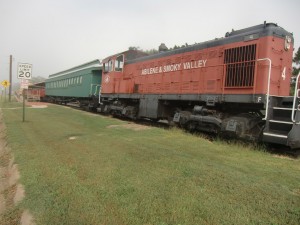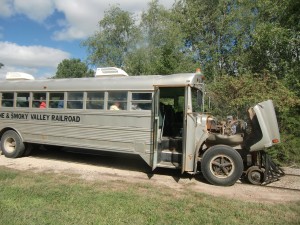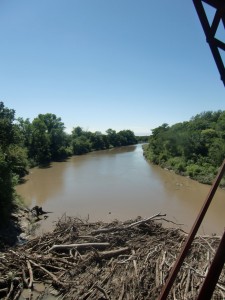ROAMING AROUND KANSAS – THE ABILENE AND SMOKY VALLEY RAILROAD
ROAMING AROUND KANSAS
This is the third in a series of articles about touring the state of Kansas
THE ABILENE AND SMOKY VALLEY RAILROAD
By Charles N. Stevens
Photos by Dolores Seidman
The early sun is just a weak disc glowing through a wall of dense ground fog, the trees only gray ghosts, the temperature a chilly 36 degrees.
As we board the cold bus for the day’s excursions, the fog begins to thin. While we drive through Abilene the pale sun shines on the dewy lawns making them look like they are covered with frost. After a short ride we arrive at the old Rock Island Railroad Station, now the terminus for the Abilene and Smoky Valley Railroad. We board a chilly old passenger car with curtains on the windows, but we plan to ride in the open air, but shaded, gondola car. Today our train will be pulled by a small diesel locomotive instead of an ex-Santa Fe steam locomotive, a great disappointment to us all.
After a blast on the engine’s horn, we creep out of the station, passing an alfalfa dehydration mill, then fields of deep green alfalfa, soybean crops with dew drops still on the leaves and corn fields so close we could touch the stalks. The fog had dissipated and the skies had cleared to a sunny day, bringing out all the colors. We enjoy passing these heartland fields, the seas of soybeans and the constant flutter of white and yellow butterflies hovering over miles of alfalfa. We pass over the muddy Smoky Valley River, through hardwood forests then arrive at the small town of Enterprise.
We detrained in Enterprise then boarded what used to be a school bus, now painted silver and equipped with auxiliary flanged wheels that would allow it to run on streets as well as rails. Soon after leaving on the old bus we inadvertently joined a parade that was traveling down the main street. I think onlookers thought we were part of the parade, but we were just on our way to another place outside of town. At the new location the driver attempts to put the bus on the old rails so that we can become a “train”. He jockeys the ancient bus back and forth many times, trying to connect the flanged wheels to the rails. At last he is successful, but now smoke billows from the engine. What now? A hydraulic line had snapped, dumping fluid on the engines hot metal. The bus is inoperative. We all scramble out of the contraption then learn that we’ll have to wait for our original tour bus back in Abilene to rescue us then take us onto the next town, Wood bine, where the rail bus would have taken us on the rails.
Our tour bus finally arrives and takes us there where we are to have lunch in a German restaurant. The town is exceedingly small with a population of only 200. The restaurant, the Me and Dee Café, is housed in what used to be an automotive shop. The lunch is very nice—salad, schnitzel, mashed potatoes, sour red cabbage, green beans and a red cherry-chocolate cake dessert. We enjoy talking to the cook and owner, a woman who had lived in Woodbine for many years and seems to love it.
Our rail bus, presumably repaired, arrives, ready to take us back on the rails, but even before we can board it, a cloud of smoke again rises from the engine, even more this time. The driver raises the hood but is met by flames. He hustles to the bus, retrieves a fire extinguisher and knocks down the fire with a blast of icy fog. This ends our association with the rickety old bus. Our tour bus transports us back to Enterprise where we’ll ride the train back to Abilene.
On the train again, we ride in an open gondola car with a canvas roof to shade us. The sky is clear now with lots of sun, the air cool. Again we slowly roll past the cornfields, swaths of alfalfa and soybeans. Silos near farm houses rise in the distance. The moving shadows of corn stalks play on the dark soil. The locomotive sounds its horn at the crossings and our rail cars rattle.
Our day is not over yet. Within minutes from the railroad station, we drive up to the Greyhound Hall of Fame. I never knew such a place existed. Inside, it is cool and quiet. We first look at a film about greyhounds and racing them. Many first class exhibits tell the story of the greyhound from ancient to modern times, their racing and breeding and the tracks where they raced. Famous dogs and their owners are immortalized in copper plaques mounted on a long wall. We learned that only seven states allow dog racing, the most avid fans being in Florida. California does not permit it.
A wall of clouds moves in from the west, replacing the clear blue of the day. It had been an interesting day, but we wonder whether they will ever get that broken down rail bus repaired.

" Today our train will be pulled by a small diesel locomotive instead of an ex-Santa Fe steam locomotive-- a great disappointment to us all.

"...the driver attempts to put the bus on the old rails so that we can become a train."

"We pass over the muddy Smoky Valley River, through hardwood forests, then arrive at the small town of Enterprise."

"Again we slowly roll past the cornfields, swaths of alfalfa and soybean. Silos near farmhouses rise in the distance."
MONTEREY PARK AUTHOR PUBLISHES 4th BOOK – Seeking More of the Sky: Growing Up in the 1930’s:
Charles “Norm” Stevens, a 43 year resident of Monterey Park has recently published his 4th book: Seeking More of the Sky: Growing Up in the 1930’s. This is the story of a young boy growing up in Inglewood, California in the l930’s. This was a time during the depression when unemployment was affecting many and the banks were closed, while the clouds of war were gathering in Europe. But he was lucky enough to be raised in a loving family, the power of that love reflected throughout his stories.
Stevens is the author of three previous books about his experiences during WWII:
An Innocent at Polebrook: A Memoir of an 8th Air Force Bombardier (Story of his 34 bombing missions from his base at Polebrook, England over Germany and France)
The Innocent Cadet: Becoming A World War II Bombardier (A prequel to the first, telling of his training in the U.S. before going overseas into combat.)
Back from Combat: A WWII Bombardier Faces His Military Future from Combat: (This book details the time from when he returned from combat in England until the end of the war.)
He is known to the readers of The Citizen’s Voice as the author of Travel Log Articles including “Cruising the Rhine and Mosel”,” Best of the West”, “In Search of Snow” , “From Paris to Normandy on the Seine”, and “Exploring New York”. He is retired, having taught for 32 years, primarily in the Montebello Unified School District.
Those interested in purchasing an autographed copy of any of his books, may contact the author at 323-721-8230 or Normstevens24@gmail.com.



